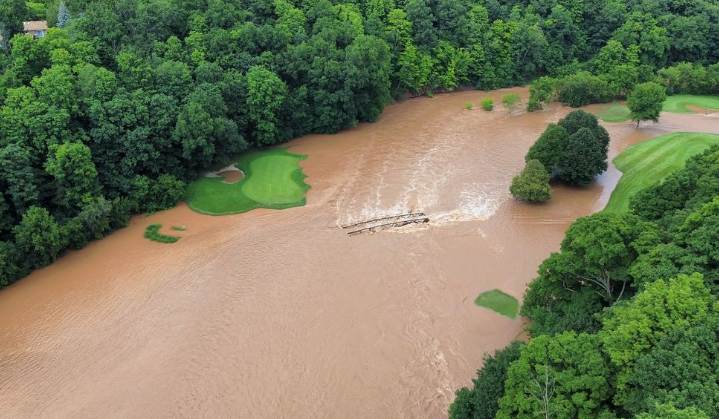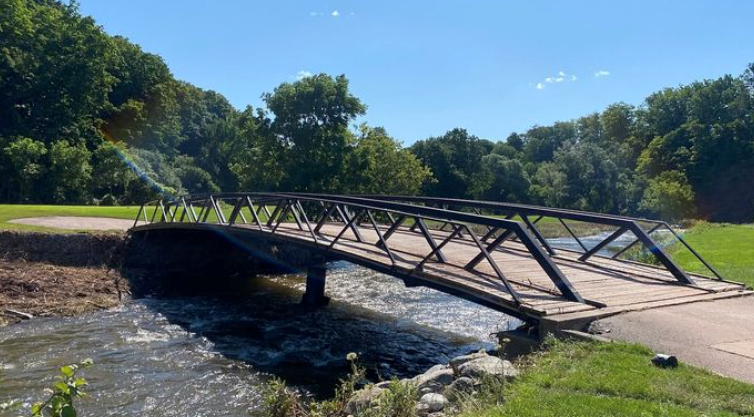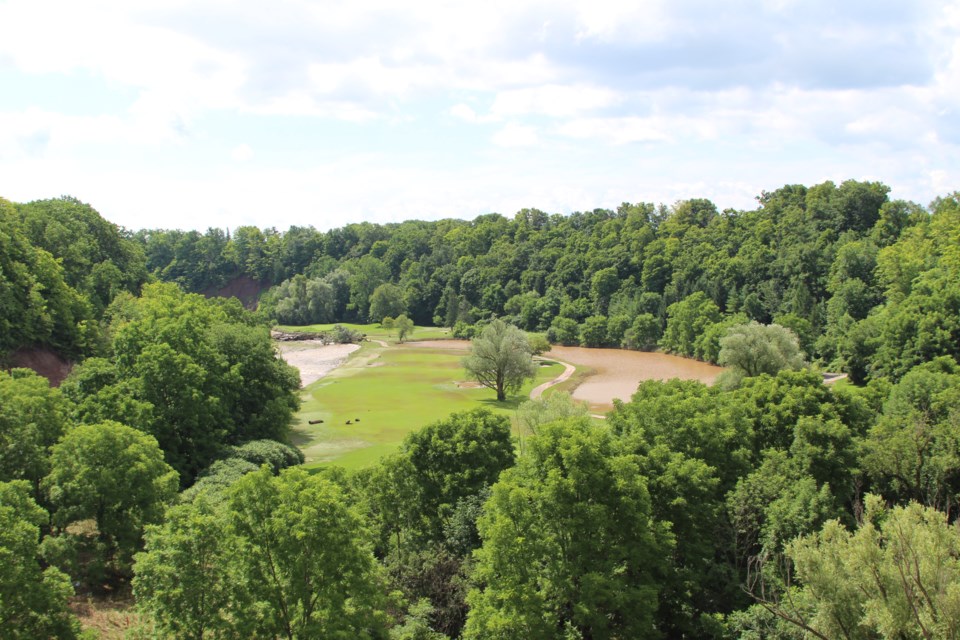In each “Behind the Scenes” segment, Village Media's Scott Sexsmith sits down with one of our local journalists to talk about the story behind the story.
These interviews are designed to help you better understand how our community-based reporters gather the information that lands in your local news feed. You can find more Behind the Scenes from reporter across Ontario here.
Today's spotlight is on Oakville News' Ben Brown, whose story "IN DEPTH: What does it take to reopen an underwater golf course?" was published on Aug. 15.
Below is the full story, in case you missed it.
It's been several weeks since Glen Abbey, Oakville's most famous golf course, was hit with severe flooding. Those heavy rains back in July closed more than half of the holes for almost a week.
Read more here: 'Most of the course is under water': Glen Abbey Golf Club closed due to flooding
Though the damage was extensive, Oakville's Glen Abbey Golf Club reopened for 18 holes almost a week to the day that the club's valley (featuring holes 11-15 on the course) was underwater.
Oakville News reporters had the opportunity to sit down with Allan Huibers, Glen Abbey's director of operations, who has worked at the course for 15 years. He walked us through the steps taken to recover from the flooding and reopen the course so quickly.
Due to Sixteen Mile Creek running through the course, flooding is a regular occurrence at Glen Abbey Golf Club. Huibers says the course staff is accustomed to managing flooding, especially during the spring.
When the water began to hit the course, staff started preparing for flooding as they normally would - but they quickly realized something about this water wasn't usual.
"The difference with this flooding was that we had Wednesday after Wednesday after Wednesday of severe rainfall and with that happening there was nowhere for the water from the Monday and Tuesday to go," said Huibers.

"This one took longer to recede, that was the issue," he continued. "You think you know what you need to do, but you don't really know what you need to do completely until it recedes down."
Once the water had receded, course staff learned that their cart paths had been destroyed, sand traps had been "wiped out," and there was debris, silt, and gravel all over the course's lower valley where holes 11-15 are located.
But now, with open terrain, Huibers and the club superintendent Andrew Gyba were able to develop an action plan with the help of fellow ClubLink courses and nearby properties.
They made calls to neighbouring properties and RattleSnake Point Golf Club in Milton, asking if employees could come over to assist clearing the course.
Without hesitation, help arrived.
"We asked if they could come over and help us get rid of the silt and gravel, get rid of the big trees that had come onto the property and found their way onto tees and fairways," Huibers said.
"If I'm a standalone golf course, that's not as easy to do," he continued. "Because we're a part of the ClubLink family, we can lean on our neighbours to give us a hand. Our superintendent, Andrew Gyba, has experience with floods, so he's as prepared as he can be when those types of things happen."
"Together with our turf staff and our other departments, mainly our golf staff here and our neighbouring properties, we put the plan into place and we were able to move at a pace that really only cost us five days."
Five days of work meant a task list for each day, requiring at least eight or nine people consistently working in the valley, working overtime, and working through weekends to ensure they could restore the quality experience that members of the prestigious golf club expect.
Read more here: Glen Abbey Golf Club officially opens for 18 holes on July 24
The first priority for the staff was to ensure that the bridges were intact and safe to ride a golf cart on. Pathways were next, especially since the course's valley has steep, winding paths that golfers would need to rely on as the grass would be off-limits to ride on.

With the grass in mind, staff had to shovel silt and gravel, which would severely damage the grass if not handled fast. Trees lodged in bridges had to be removed as well.
"Once you get the trees out of the bridge and you've removed as much silt and gravel from it, you repair that cart path, the bridge you already know is safe, and then you start removing debris from the golf course," said Huibers. "Unfortunately for us, and I'm sure for all the other golf courses now, you need to rebuild your sandtraps."
In addition to bringing in new sand and shaping them to look as crisp as they did before the flooding, the drainage also had to be taken care of in the bunkers.
All of this work came in addition to maintenance tasks on the other 13 holes located in the upper area of the course.
With enough time and energy, things quickly started shaping up. The bridges, once submerged in brown floodwater, looked pristine again.

Pathways were cleared, and the grass began to recover as silt and gravel were removed.

The sand traps were rebuilt and reshaped, restoring their crisp appearance and ensuring proper drainage.
"Being a member at Glen Abbey for the last 21 years, I was very surprised to see the power of the river and the amount of flooding it produced," said long-time club member Carmen Bonfiglio.
"The work that was put in by the superintendent, Andrew Gyba, and his staff with the direction of Allan Huibers was off the charts, they accomplished a massive result due to their hard work and years of experience," he continued.
Staff at Glen Abbey did not disclose the damage estimates or the cost to repair the course. A standard round of 18 holes at Glen Abbey typically costs around $241 per person, and initiation fees for members are rumoured to be comparable to the price of a new car.
While the course was under repair, only 13 holes were available for play.
"We have a duty to the members that we do have here and the public that's coming here to play and the corporate events that have been booked in advance to allow them to do what it is they need to do," said Huibers who also noted that everyone who visited the course during the closure was very understanding throughout the reopening process.
"But that's a lot of communication," he said. "That's a lot of talk and calls and letting them know what to expect and being very upfront, telling them our plan and what we're doing and what it's going to look like, those are the things that really helped the transition."
Preparing for intense flooding isn't something golf courses can typically anticipate which makes proactive measures relatively limited. For Huibers and Gyba, their success came down to experience, quick decision-making and being able to rely on their "ClubLink family," in addition to having a staff willing to go the extra mile.
Huibers imagined a hypothetical scenario: if he were at a private club without his current team and only had five days to reopen after flooding.
"I would have a fund set aside and an absolute plan in place once that water recedes to get moving, that's how you can prepare."
"That being said," Huibers continued, "I look at Sixteen Mile Creek today and it's down now to the normal level that it is at this time of year, and we could get four rainstorms and we would be fine, this was five plus two on top of it. It's part of doing business, the lure of this golf course, other than the Canadian Opens, is the valley, the back nine at this golf course is the most beautiful nine in Canada but it's a risk, as creek flows through."
"I just don't think anybody could have ever prepared for a month's worth of rain in two days."
As golfers return to the course, they can once again enjoy the beauty and prestige that comes with playing at Glen Abbey, with the knowledge that the team behind it is prepared to handle even the most unexpected challenges.

